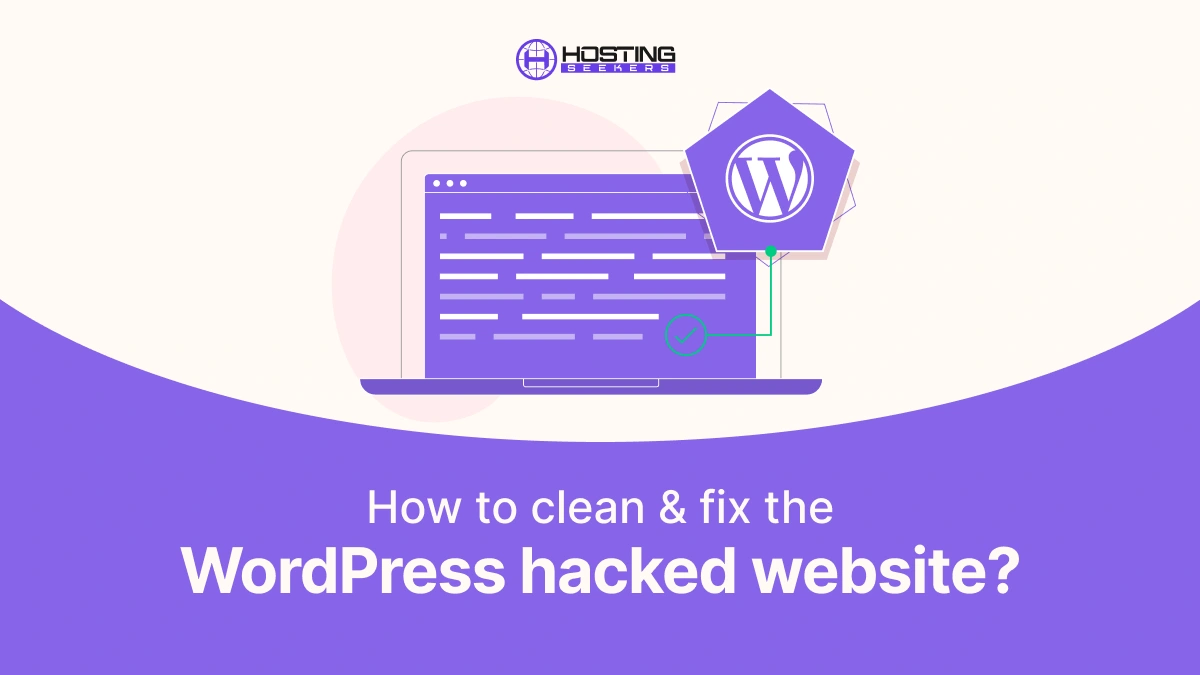
Have you ever got your wordpress site hacked? Running a website online increases the higher chances of hacking a website
and we understand how stressful it can be. Well, don’t worry, in this ultimate guide we will help you to clean & fix the WordPress hacked website and how you can regain control over your website.
Signs and Signal that Your WordPress Site Might be Hacked
All of a sudden, you may realize that your WordPress website is acting inappropriately and you see that it has been
hacked already, for instance you cannot even understand if your WordPress has been hacked or not. So, here are some
signs that may indicate a hack:
- You are not able to access your WordPress dashboard even with the appropriate login details.
- The website mainly looks different without you making any changes. For instance, your homepage might get replaced or
new content may appear without your knowledge. - Your website can send visitors to another strange websites they didn’t intend to visit.
- Web browser shows a warning when you or others try to visit your website, indicating it may not be safe.
- Security plugins notify you that there’s a breach or unexpected changes on your website.
- Your hosting company also notifies you about sudden activities happening in your hosting account.
Why Your WordPress Site Was Hacked?

Your WordPress site got hacked for several reasons. The more ranked your website is on search engines or the more
traffic it has, the higher is the probability that it gets hacked. The more visible your WordPress site is, the higher
the probability it will get hacked. This is because it is easier to find, and the hackers can charge a higher amount.
Government websites, charity webpages, and other WordPress sites are common targets of WordPress hacks. It’s easy to
steal data, extort money from WordPress
site owners, or even ruin someone’s reputation. Here are some reasons why your WordPress has been hacked:
1. Insecure Web Hosting
Insecure web hosting can leave your site vulnerable to
attacks like Shared Hosting Risks in which if you’re on a shared hosting plan, your site shares server space with
multiple other sites. If one of these sites is compromised, it can potentially affect all sites on the same server.
Moreover, some hosting providers may not implement adequate security measures such as firewalls, intrusion detection
systems, and regular security audits.
2. Outdated WordPress Version of Themes & Plugins
Using outdated versions of WordPress, themes, and plugins is one of the most common reasons for site hacks. Each update
usually includes patches for security vulnerabilities that have been discovered since the last release.
3. Free Themes & Plugins
Downloading Free themes and plugins from unverified sources can result in installing malicious code on your site.
Hackers often disguise malware within seemingly harmless free themes and plugins. Moreover, Free themes and plugins may
not be regularly updated or supported, which means any vulnerabilities they contain might not be addressed promptly.
4. File Permission Issue
Improper file permissions can give hackers access to critical files on your server. File permissions dictate who can
read, write, and execute files on your server. So, If files or directories have overly permissive settings, unauthorized
users may gain access and modify or upload malicious scripts.
5. Weak Passwords
Utilizing weak or easily guessable passwords makes it seamless for attackers to gain illegal access to your website.
It’s best to avoid simple passwords which are really easy to guess, Also, ignore using the same passwords for every
single thing, as hacker can access all your database by using just one password.
6. SQL Injection
Poorly coded themes or plugins can be susceptible to SQL injection attacks, where an attack easily manipulates the
website’s database and queries to gain unauthorized access.
7. Cross-Site Scripting
Vulnerabilities in plugins or themes can enable attackers to easily inject suspicious scripts into your site, which can
then be executed in browser of users.
8. Social Engineering
Human errors also include the use of phishing scams and revealing confidential data to unauthorized persons. It is
important to understand that hackers are constantly evolving with their techniques while new vulnerabilities could be
discovered anytime. For your WordPress website to remain secure you need to follow best website security practices. Keeping your
WordPress installation, themes, and plugins up to date is also a must.
How to Fix and Clean WordPress Hacked Website?

1. Download the Site to Local Server and Scan it
Before you begin cleaning your hacked WordPress site, it’s crucial to work on a local server. This way, you can avoid
further infection or downtime on your live site. Start by downloading the site to the local server and backing up your
entire site. Always have a backup before making any changes to avoid data loss.
2. Setup Local Environment
Set up a local server environment such as XAMPP, WAMP, or MAMP. Create a new database in your local server environment.
Copy your site files into the local server’s web directory and import your database backup into the local server’s
database.
3. Scan the Website
Once your site is set up locally, scan for malware using tools like Sucuri, Wordfence, or Anti-Malware Security and
Brute-Force Firewall. Scanning your site files and database will help identify malicious code and infected files.
4. Clean the code
After identifying the infected files, it’s time to clean the code. Open the infected files in a code editor and look for
common malicious code patterns, such as Base64 encoded strings, iframe tags, and suspicious PHP or JavaScript. These
often hide malicious scripts or embed malicious content. Carefully delete or comment out the malicious code, ensuring
you do not remove legitimate code. Removing the malicious code is crucial to restoring the integrity of your site.
5. Replace WordPress Core Files
Replacing core WordPress files is another important step to clean hacked WordPress website. Download the latest version of WordPress from the official
website and replace the core files in your local server’s web directory (except the wp-config.php file and the
wp-content directory). This ensures no core files are compromised.
6. Change and Update Hosting Password
After cleaning your WordPress site, updating your hosting password is crucial to prevent further unauthorized access.
Log into your hosting provider’s account, typically through their web portal. Navigate to the account settings or
security section, where you can change your password. Choose a strong, unique password that combines uppercase and
lowercase letters, numbers, and special characters. Avoid using easily guessable information like common words or
sequences.
7. Change and Update WordPress Password
Equally important is updating your WordPress admin password. Log into your WordPress dashboard and go to the Users
section. Find your admin account and click on it to edit. Here, you can update your password. Similar to your hosting
password, choose a strong, unique password to enhance security. Additionally, consider enabling two-factor
authentication (2FA) for an added layer of protection.
8. Delete unnecessary Plugins
Remove Suspicious and Unnecessary Plugins and Themes
In this step, go through your WordPress plugins and themes. Remove anything that seems suspicious or unnecessary:
- If you find plugins you didn’t add, get rid of them. They might be harmful.
- A plugin may have security problems if it hasn’t received an update in a while. To be safe, keep them updated.
- Remove a plugin if you are unsure about its origin. Rely only on reliable sources to steer clear of any issues.
How to Prevent Your WordPress Site from Being Hacked?

So as you have cleaned your website and also reset your passwords. But there’s more you can do to prevent WordPress site
being hacked.
1. Make Sure All Your Passwords are Updated
Ensure that all passwords relating to your website, not just your WordPress admin password, are reset and that you are
using strong passwords.
2. Don’t Install Insecure Plugins
Only install plugins and themes from reputable sources, such as the official WordPress repository, reputable
marketplaces, or directly from developers you trust. Before installing a plugin, check its reviews, update history, and
support forum to ensure its actively maintained and secure.
3. Remove Unused Themes and Plugins from Your WordPress
Remove any unused themes and plugins from your wordpress site. These can become security risks if they are not regularly
updated. Also, delete any unnecessary files and directories from your WordPress installation.
4. Update Core WordPress Theme and Plugins.
Log into your WordPress dashboard, and you will often see an update notification at the top if a new version is
available. Go to Dashboard > Updates and click the Update Now button. Navigate to Appearance > Themes in your
dashboard. If an update is available for your active theme, you will see a notification. Click the Update Now link to
apply the update. Navigate to Appearance > Themes in your dashboard. If an update is available for your active theme,
you will see a notification. Click the Update Now link to apply the update.
5. Install the Security Plugin
Install an SSL certificate on your website to encrypt data transmitted between your server and visitors’ browsers. This
not only secures sensitive information but also improves your site’s SEO ranking.
6. Install the security Plugin
Install a security plugin such as Wordfence, Sucuri, or iThemes Security on your local WordPress installation to scan
for malware and vulnerabilities.
Summing Up
Having your website is hacked, it can be a troubling incident because the site is no longer accessible to the end user;
in turn, this may negatively affect your business. In this article, we have exhaustively covered the topic of WordPress
hacked website fix; what drives people to hack WordPress sites, and many more details in this guide. By reading through this guide,
you will gain a solid understanding of these topics to enable you to protect your web page.
Frequently Asked Questions
Q 1. What are the steps should you take if you suspect a WordPress site has been hacked?
Ans. If you suspect your WordPress site has been hacked, follow these steps to fix hacked website:
-Scan for malware using a security plugin.
-Change all passwords.
-Restore from a clean backup.
-Remove malware and suspicious files.
-Update WordPress, themes, and plugins.
-Check for unauthorized user accounts.
-Implement additional security measures.
Q 2. What if my WordPress site is seriously compromised?
Ans. In such case, hire a professional WordPress security services and you can also contact your web hosting provider for assistance.
Q 3. How do I remove viruses from my WordPress website?
Ans. To remove viruses from your WordPress website, follow these steps:
-Backup your site.
-Scan for malware.
-Clean infected files manually or use a removal tool.
-Replace core files with fresh copies.
-Update all software.
Q 4. Can a hacked website be recovered?
Ans. Yes, by identifying and removing malicious code, restoring from a clean backup, updating software, and enhancing
security measures. Consider professional help if needed.
Q 5. What are 4 things to do when you get hacked?
Ans. If you get hacked, here are four key actions to take immediately:
-Change all passwords.
-Scan and clean your site.
-Restore from a clean backup.
-Reinstall WordPress.
